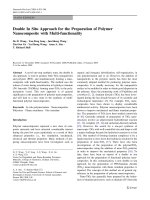DOUBLE COUNTING PROOFS IN COMBINATORICS
Bạn đang xem bản rút gọn của tài liệu. Xem và tải ngay bản đầy đủ của tài liệu tại đây (5.56 MB, 16 trang )
DOUBLE COUNTING PROOFS IN
COMBINATORICS
INTRODUCTION
Drichlet's principle, exclusionary inclusion principle, developing recursion formulae, generating and counting
functions in two ways are just a few of the methods available to handle combinatorial problems. Math problems that
use counting thinking in two different ways are useful problems to train and test students' thinking abilities. It is often
difficult to discern the relationship between the hypothesis or between the hypothesis and the conclusion since it is an
abstract problem and it is required to know how to exploit the problem's assumptions. Furthermore, we must analyze
numerous problems using combinatorial inequality.
Indeed, problems with this tool emerge frequently in tests such as the IMO, China MO, Russia MO, and even the
VMO exam, which we will use to explain this topic in this lesson.
However, there isn't a lot of literature on the subject. We actually wrote the topic: "Double counting proofs in
combinatorics" based on our research and reference sources.
DOUBLE COUNTING
Counting in two ways is a common method in life, for example the following problem: A company imports 3 carts of goods A, B, C including two
types of goods I and II. In which, car A has 3 types I and 2 types II, car B has 4 types I and 6 types II, car C has 4 types I and 6 types II. Calculate the
quantity of goods that the company imports. This is a fairly simple problem, to solve the problem we can make a table and then we can calculate it in
two ways as follows: Calculate the total number of rows on each car and then add it up; or we can calculate the total number of class I goods on 3 cars,
the total number of class 2 goods on 3 cars, and then add them
A
B
C
Sum
I
3
4
4
11
II
2
6
6
14
Sum
5
10
10
25
Above is an example of calculating in two ways, we can sum by row or we can sum by column. More generally, we have the following algebraic
formula:
In some situations, the problem requires counting the number of elements of a set, regardless of how we count, then counting in two ways
gives us the same answer, then we will establish a combinatorial equality. For a simple example like counting the number of subsets of a
set with n elements, we can count the number of sets with k elements with k = 0, 1, …, n, taking the sum we get
But if we count the other way as follows: consider any set A, then element i can either belong to A or i not to A, each element has 2 cases,
n
but there are n elements, so the number of sets A is 2 .
From there we have the equality .
Counting in two ways provides a method for proving equality involving binary
In addition, counting in two ways can be applied in inequalities problems, combinatorial extremes or some problems of proof of
existence. To use the two-way counting method, requires students to know and apply basic counting well. This article is used to teach
10th graders specializing in Mathematics, they are just starting to get acquainted with combinatorial problems in general and counting
problems in particular, so the examples given are not of high difficulty help them get used to this method.
CONTENTS
Multiplication Principle
Bijections and Double Counting
Inclusion-Exclusion
Counting trees
Multiplication Principle
The number of sequences (s1, s2, · · ·, sn) such that there are ai choices for
on
i
t
a
c
i
l
tip
1. Mul
le
p
i
c
n
i
r
P
si after having chosen s1, s2, · · · , si−1 for each
i = 1, 2, · · · , n is exactly a1a2 · · · an.
In particular, if S1, S2, · · · , Sn are finite sets, then
|S1 × S2 × · · · × Sn| =
We may split the digits 1–9 into odd and even, say = {1 3, 5, 7, 9} and ={2, 4, 6, 8}. Then the
stringswhich satisfy the required property must have ∈ and ∈.
By the Multiplication Principle, we have that the number of such strings is=.Sometimes it is
Example: How many strings of digits from 1–9 of length 5 have an odd number
in the odd positions and an even number in the even positions?
tricky to count the number of sequences we are interested in all at once, but more straightforward
once break the problem into smaller, disjoint pieces.
Let’s count the number of binary strings of length n in two different ways.
Going through each position of a binary string, there is a choice of whether
Prove the following identity
=
that position should be a 0 or a 1. Since there are n positions, by the
Multiplication Principle there are binary strings of length n. Now let’s
count binary strings based on the number of 1s there are. By the previous
example there are binary strings with k 1s. A binary string can have
between 0 and n 1s inclusive. By the Summation Principle there are binary
strings of length n.
Example: A mother has 23 one dollar bills that she wants to distribute between her 4
children such that each child receives at least 1 dollar. In how many ways can she do this?
2.
ble
u
o
D
d
n
a
s
n
o
i
t
Bijec
g
n
i
t
n
u
o
C
Solution: We note that in this example we are assuming that the children are distinct (their order matters), but the
one dollar bills are indistinguishable (their order does not matter). We can reformulate this problem into an integer
programming problem. We want the number of integer solutions to:
subject to the constrain . This is exactly a composition of 23 into 4 parts! So the number of ways is What if we
drop the assumption that each child receives at least one dollar? Then we have changed the constraints To solve
this problem we may create new variable . Then the equation becomes
subject to constraints . . The rest is left as an exercise. We end this section with the Binomial Theorem.
Example: (Counting Derangements). A sequence of length from which is a bijection is called a
permutation. We use the notation Sn to denote the set of all permutations of . A permutation σ ∈ Sn
is called a derangement if for all
. How
many derangements of
3.
sion
u
l
c
x
E
n
Inclusio
Example: (Counting Surjections). Let How many surjections are there ?
are there?
(Counting Derangements). A sequence of length from which is a bijection is called a permutation. We use the notation S to denote the set of all permutations of . A permutation σ ∈ S is called a
n
n
derangement if for all . How many derangements of are there?
We can solve this problem by using the Inclusion-Exclusion Theorem. We will let the set be the set of permutations τ such that τ (i) = i. Then a permutation σ is a derangement if it is not in any of the sets A . Let have size . To apply the theorem we must be able to
i
calculate the size of
A permutation is in this intersection if and only if it is fixed on the set of indices of . The permutation may do anything else outside of those indices (on other positions). Therefore,
The number of subsets of of size is exactly , therefore the Inclusion-Exclusion Theorem gives us that
This is a good result, but we should try to simplify the formula. Let D be the set of all derangements
Recalling from calculus that the Taylor series for is
We see that the sum is a truncated Taylor series for . This tells us that as , the number of derangements of tends to of the total number of permutations of .
A function f is not a surjection if there is a such that for all . Therefore, let be the set of functions such that is not in the range of . Let F be the set of all functions
from . Then
is exactly the number of surjections from to (let’s call this set . Then Inclusion-Exclusion tells us
We must count the size of
(Counting Surjections). Let How many surjections are there ?
Functions in this intersection have a fixed set of values in which are not in the range of the function. Therefore, any function from to is in the intersection. There are
of these functions. So
4.
Cayley's formula implies that there is 1 = tree on two vertices,
3 = trees on three vertices, and 16 = trees on four vertices
ees
r
t
g
n
i
t
Coun
Adding a directed edge to a rooted forest
What is the number of different trees that can be formed from a set of n distinct vertices? Cayley's formula gives the answer . Aigner & Ziegler (1998)
list four proofs of this fact; they write of the fourth, a double counting proof due to Jim Pitman, that it is "the most beautiful of them all."
Pitman's proof counts in two different ways the number of different sequences of directed edges that can be added to an empty graph on n
vertices to form from it a rooted tree. One way to form such a sequence is to start with one of the possible unrooted trees, choose one of its n vertices
as root, and choose one of the (n-1)! possible sequences in which to add its n-1 (directed) edges. Therefore, the total number of sequences that can be
formed in this way is
Another way to count these edge sequences is to consider adding the edges one by one to an empty graph, and to count the number of choices
available at each step. If one has added a collection of n-k edges already, so that the graph formed by these edges is a rooted forest with k trees, there
are n(k-1) choices for the next edge to add: its starting vertex can be any one of the n vertices of the graph, and its ending vertex can be any one of the
k-1 roots other than the root of the tree containing the starting vertex. Therefore, if one multiplies together the number of choices from the first step,
the second step, etc., the total number of choices is
Equating these two formulas for the number of edge sequences results in Cayley's formula:
and
As Aigner and Ziegler describe, the formula and the proof can be generalized to count the number of rooted forest with k trees, for any k
CONCLUSION
The topic of counting in these two ways is an important part of the content that the author has lectured to the school and provincial student teams.
In fact, teaching students the two-way counting method in combinatorial math is an effective way to improve students' thinking. From simple
exercises to count pairs and triples to exercises that must use combinatorics inequalities or problems using the membership matrix, it helps to train
the ability to solve simple to complex math problems. complex, making students not only improve their own ability but also love combinatorial
problems - a necessity when learning combinatorics content.
Thank you!









